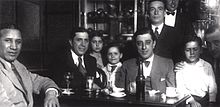| Revision as of 09:37, 23 December 2009 editSmackBot (talk | contribs)3,734,324 editsm Delink dates (WP:MOSUNLINKDATES) using Project:AWB← Previous edit | Latest revision as of 15:50, 22 November 2024 edit undoSimeon (talk | contribs)Autopatrolled, Extended confirmed users818,073 editsm Changing short description from "Argentine musician" to "Argentine musician (1899–1967)"Tag: Shortdesc helper | ||
| (31 intermediate revisions by 26 users not shown) | |||
| Line 1: | Line 1: | ||
| {{Short description|Argentine musician (1899–1967)}} | |||
| {{Refimprove|date=August 2009}} | {{Refimprove|date=August 2009}} | ||
| ⚫ | ] | ||
| ] | |||
| ⚫ | '''Pedro Mario Maffia''' (August 28, 1899 – October 16, 1967) was an ] ]ist, ], ] and teacher, as well as starring in several tango films. | ||
| ⚫ | ] | ||
| ⚫ | The son of Italian immigrants Angelo V. Maffia and Luisa Spinelli from ], Maffia had a hard upbringing; he was beaten with a chain by his father and lived in dire poverty. He eventually ran away from home to live in the town of ] in ], where he was discovered by ] and ]. | ||
| ⚫ | '''Pedro Mario Maffia''' (August 28, 1899 – October 16, 1967) was an ] ]ist, ], ] and teacher, as well as starring in several tango films. | ||
| ⚫ | Maffia is remembered as a pioneer of the bandoneon and a great stylist. He was one of the first to play the instrument ]. He had a relaxed playing style and an inventiveness for misplaced accents and nuances. | ||
| ⚫ | Maffia had a hard upbringing |
||
| ⚫ | Maffia starred in a number of tango films including '']'' (1933), '']'' (1936) and '']'' (1966). He also worked as a music teacher, and wrote an important method of teaching the ]. | ||
| ⚫ | Maffia is remembered as a pioneer of the |
||
| ⚫ | The bandoneonist ] dedicated a song to him entitled ''A Pedro Maffia''. | ||
| ⚫ | Maffia starred in a number of tango films including ] (1933), '']'' (1936) and '']'' (1966). He also worked as a music teacher, and wrote an important method of teaching the ]. | ||
| ⚫ | The bandoneonist ] dedicated a song to him entitled |
||
| == External links == | == External links == | ||
| * | * at todotango.com | ||
| * | * at tango.info | ||
| {{Authority control}} | |||
| {{DEFAULTSORT:Maffia, Pedro}} | {{DEFAULTSORT:Maffia, Pedro}} | ||
| Line 22: | Line 25: | ||
| ] | ] | ||
| ] | ] | ||
| ] | ] | ||
| ] | ] | ||
| ] | ] | ||
| ] | |||
| ] | |||
| ] | |||
| ] | |||
| ] | |||
Latest revision as of 15:50, 22 November 2024
Argentine musician (1899–1967)| This article needs additional citations for verification. Please help improve this article by adding citations to reliable sources. Unsourced material may be challenged and removed. Find sources: "Pedro Maffia" – news · newspapers · books · scholar · JSTOR (August 2009) (Learn how and when to remove this message) |


Pedro Mario Maffia (August 28, 1899 – October 16, 1967) was an Argentine tango bandoneonist, bandleader, composer and teacher, as well as starring in several tango films.
The son of Italian immigrants Angelo V. Maffia and Luisa Spinelli from Lombardy, Maffia had a hard upbringing; he was beaten with a chain by his father and lived in dire poverty. He eventually ran away from home to live in the town of Punta Alta in Buenos Aires Province, where he was discovered by Carlos Gardel and José Razzano.
Maffia is remembered as a pioneer of the bandoneon and a great stylist. He was one of the first to play the instrument a cappella. He had a relaxed playing style and an inventiveness for misplaced accents and nuances.
Maffia starred in a number of tango films including ¡Tango! (1933), Canillita (1936) and Fueye querido (1966). He also worked as a music teacher, and wrote an important method of teaching the bandoneon.
The bandoneonist Aníbal Troilo dedicated a song to him entitled A Pedro Maffia.
External links
- Pedro Maffia at todotango.com
- Pedro Maffia at tango.info